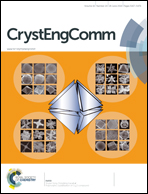Design and syntheses of hybrid supramolecular architectures: based on [Fe(C2O4)3]3− metallotectons and diverse organic cations†
Abstract
Employing [Fe(C2O4)3]3− (C2O42− = oxalate) metallotectons as building units, a series of 3D iron–organic compounds with formulae [K(H-L1)2{Fe(C2O4)3}·2H2O] 1, [(H-Phen){Fe (C2O4)2}(Phen)·3H2O] 2, [(H2-L2)2{Fe2(C2O4)3Cl4}] 3, [K(H2-L3){Fe(C2O4)3}·2H2O] 4, [K(H2-L4){Fe(C2O4)3}·H2O] 5, [(H-L5){Fe(C2O4)(L5)}] 6, [(H2-L6)2{Fe2(C2O4)4(OH)2}·2H2O] 7, [(H-L7)4{Fe(C2O4)3}Cl·2H2O] 8 (with L1 = 2-methylbenzimidazole, Phen = 1,10-phenanthroline, L2 = 1,4-bis(imidazol-1-ylmethyl)benzene, L3 = 1,4-bis((2-methylimidazol-1-yl)methyl)benzene, L4 = 1,1′-butane-1,4-diylbis(1H-imidazole), H-L5 = 1H-benzotriazole, L6 = 1,2-ethylenediamine, L7 = melamine) have been synthesized and characterized by single-crystal X-ray diffraction. Compounds 1 and 5 possess different 2D [KFe(C2O4)3]2− layers. Compound 2 features a 2D hydrogen bonded network completed by trimer water clusters and [Fe(C2O4)2(Phen)]− anions via hydrogen bonds. Compounds 3–6 feature a series of 2D layers, which are further extended into a 3D supramolecular structure through C–H⋯O hydrogen bonds. Distinct [Fe2(C2O4)3Cl4]4− units and [Fe2(C2O4)4(OH)2]4− units are shown in compounds 3 and 7, respectively. Trinary hydrogen bonds and double hydrogen bonds are simultaneously displayed in 8 as well as N–H⋯Cl and O–H⋯Cl hydrogen bonds. Furthermore, in order to examine the thermal stability of all compounds, TGA was carried out.
![Graphical abstract: Design and syntheses of hybrid supramolecular architectures: based on [Fe(C2O4)3]3− metallotectons and diverse organic cations](/en/Image/Get?imageInfo.ImageType=GA&imageInfo.ImageIdentifier.ManuscriptID=C4CE00357H&imageInfo.ImageIdentifier.Year=2014)

 Please wait while we load your content...
Please wait while we load your content...